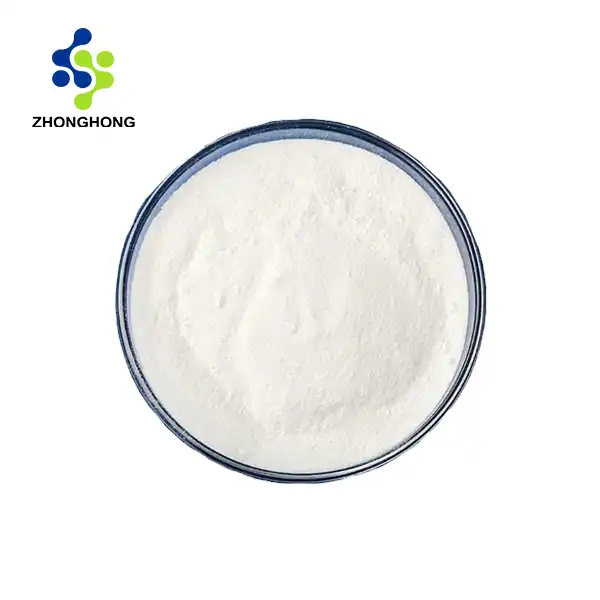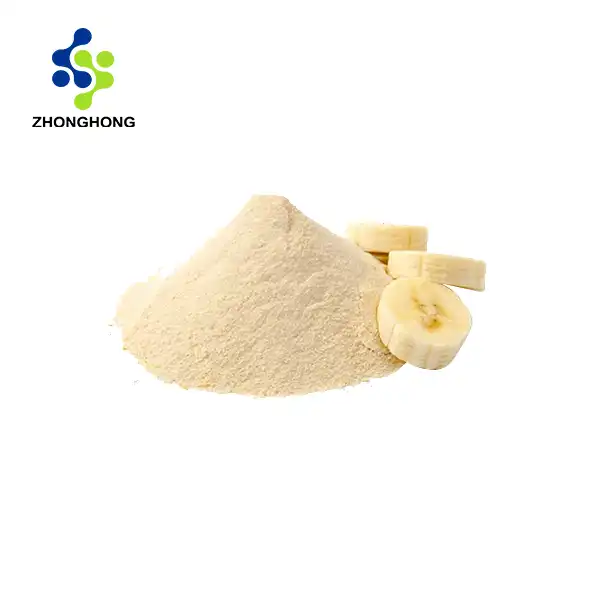Research progress | Exploration of the relationship between ergotamine and human health
2021-11-19
Recent research findings
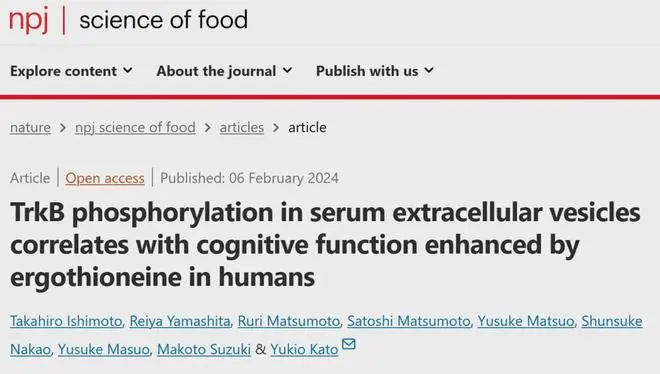
TrkB phosphorylation in serum extracellular vesicles is associated with enhanced human cognitive function by ergotamine
Abstract: Oral administration of the antioxidant amino acid ergotamine (ERGO) derived from food can effectively distribute it in the brain and enhance cognitive function. However, the impact of ERGO on cognitive impairment and its potential mechanisms are still unclear. The experiment found that the cognitive function and hippocampal neurogenesis of mice fed a diet without ERGO were lower than those fed a control diet. In addition, supplementing ERGO to control dietary ERGO levels can reverse these effects and restore ERGO concentrations in plasma and hippocampal neurons. ERGO induced cognitive function recovery and hippocampal neurogenesis were blocked by inhibiting the neurotrophic factor receptor tropomyosin receptor kinase B (TrkB), while hippocampal phosphorylation of TrkB decreased, indicating that TrkB is involved in these events in mice. Phosphorylated TrkB was also detected in extracellular vesicles (EVs) extracted from the serum of volunteers who received oral placebo or ERGO tablets. Importantly, the proportion of serum EV derived phosphorylated TrkB in the ERGO treatment group was significantly higher than that in the placebo treatment group, and positively correlated with serum ERGO concentration and several cognitive domain scores of Cognitrax. In summary, TrkB phosphorylation is involved in ERGO induced cognitive enhancement in mice, and the level of TrkB phosphorylation in serum EVs can quantitatively represent ERGO induced cognitive enhancement in humans.
Conclusion: This study suggests that a diet without ERGO leads to hippocampal neurogenesis and cognitive impairment, accompanied by a decrease in plasma ERGO levels and TrkB phosphorylation levels in the hippocampus. In addition, oral supplementation of ERGO alone can restore these injuries, accompanied by the recovery of ERGO levels in mouse plasma and hippocampus. This suggests that the level of ERGO in the body may play an important role in maintaining cognitive function, and supplementing ERGO will help prevent cognitive decline, at least in rodents. The p-TrkB/TrkB ratio in serum EVS of the group taking ERGO tablets was significantly higher than that of the placebo group, and the p-TrkB/TrkB ratio in serum EVS was positively correlated with systemic ERGO levels and cognitive enhancement after taking tablets containing ERGO. In summary, oral supplementation of ERGO can restore hippocampal neurogenesis and cognitive impairment in mice fed a diet without ERGO, possibly through phosphorylation of TrkB. This indicates that ERGO plays a fundamental role in brain function. In addition, TrkB phosphorylation was detected in human serum EVS and is believed to be associated with ERGO induced cognitive enhancement in humans.
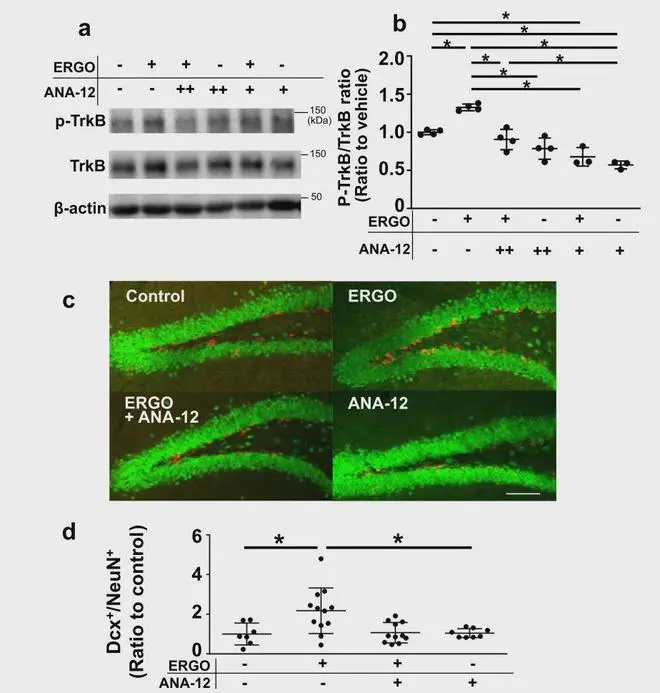
Reference:
ISHIMOTO T, YAMASHITA R, MATSUMOTO R, et al. TrkB phosphorylation in serum extracellular vesicles correlates with cognitive function enhanced by ergothioneine in humans[J]. npj Science of Food, 2024, 11: 8. DOI:10.1038/s41538-024-00250-5.
Ergothionein and mitochondria: important protective mechanisms?
Abstract: Mitochondrial dysfunction is associated with various human diseases, including many neurodegenerative and cardiovascular diseases, metabolic diseases, cancer, and respiratory system diseases. Research has shown that ergotamine (ET), a unique dietary sulfur ketone, has the potential to prevent mitochondrial damage and improve disease outcomes. However, there is no clear research to prove that ET can be absorbed by mitochondria. In addition, the expression of the known ET transporter OCTN1 on mitochondria is still controversial. In this study, mass spectrometry was used to demonstrate the direct uptake of ET in isolated mitochondria and its presence in mitochondria isolated from ET treated cells and animals. Mitochondria isolated from OCTN1 knockout mouse tissues, although damaged, can still detect ET uptake, which increases the possibility that alternative transporters may promote mitochondrial ET uptake. The author's data confirms that ET can enter mitochondria, providing a basis for further research on ET in preventing mitochondrial dysfunction in human diseases.
Conclusion: This study provides conclusive evidence that ET is taken up and accumulated in mitochondria using different methods. Although it was previously speculated that ET could protect mitochondria due to the presence of OCTN1 on the mitochondrial membrane, the authors' study of mitochondria isolated from OCTN1 −/− mice showed that ET uptake was not significantly affected, indicating the existence of another mitochondrial transport mechanism for ET. The accumulation of ET suggests a possible role in maintaining the dynamic balance of redox in mitochondria, which is consistent with the author's earlier hypothesis that ET may preferentially accumulate in sites exposed to high oxidative stress. Further research suggests that in diseases associated with mitochondrial damage, such as neurodegenerative diseases, ET mediated prevention and/or treatment of mitochondrial dysfunction will help determine the therapeutic effect of ET.

Reference:
FONG Z W, TANG R M, CHEAH L K, et al. Ergothioneine and mitochondria: an important protective mechanism? [J]. Biochemical and Biophysical Research Communications, 2024, 726: 150269. DOI:10.1016/j.bbrc.2024.150269.
The effects of aging and pretreatment with ergotamine on naphthalene induced pulmonary toxicity
Abstract: Aging increases susceptibility to lung diseases, but research on this topic is insufficient, especially in relation to environmental exposure. Most rodent studies have used young mice. The aim of this study is to determine the pulmonary toxicity of naphthalene (NA) and the effects of dietary antioxidant ergothioether (ET) on the liver and lungs of middle-aged mice. NA can cause damage to the conductive respiratory epithelium in the lungs of young mice, but the toxicity of NA has not yet been demonstrated in middle-aged mice aged 1-1.5 years. Endotoxins are dietary antioxidants synthesized by bacteria and fungi. The ET transporter protein (ETT) SLC22A4 is upregulated in tissues undergoing high levels of oxidative stress. This study used middle-aged male and female C57BL/6J mice, fed with synthetic feed without ET from conception, and orally administered 70 mg/kg ET for 5 consecutive days. On the 8th day, mice were given a single intraperitoneal injection of 50, 100, 150, or 200 mg/kg of NA. Samples were collected 24 hours after NA injection to measure plasma ET, reduced glutathione (GSH), and oxidized glutathione (GSSG) concentrations. Inspect histopathology, morphometrics, and gene expression. Histopathological studies of mice exposed to 100 mg/kg NA showed that after ET pretreatment, terminal respiratory toxicity was reduced in both male (P ≤ 0.001) and female (P ≤ 0.05) middle-aged mice. The author's findings in this study provide the first evidence of the toxicity of NA in middle-aged mice and demonstrate some of the effects of ET in reducing NA toxicity.
Conclusion: In studying middle-aged mice, this study provides the first evidence of gender differences in the lungs, understands the toxicity of NA, and explores the effects of ET on GSH synthesis in the liver and lungs. Understanding the lung biology during the aging process, including the age before most elderly age groups, will be important for understanding the potential health impacts on these populations. The experiment found that the first step required to understand the lung specific response in middle-aged mice includes the key ability to detoxify foreign bodies in the lungs and the potential benefits of introducing dietary antioxidants. The key gene expression differences discovered in this study exposed susceptible areas based on age, gender, and lung location. In addition, this study found that ET is a potential pre-treatment for NA toxicity, and has little effect on reducing toxicity when taken orally at certain doses of NA and certain sites.
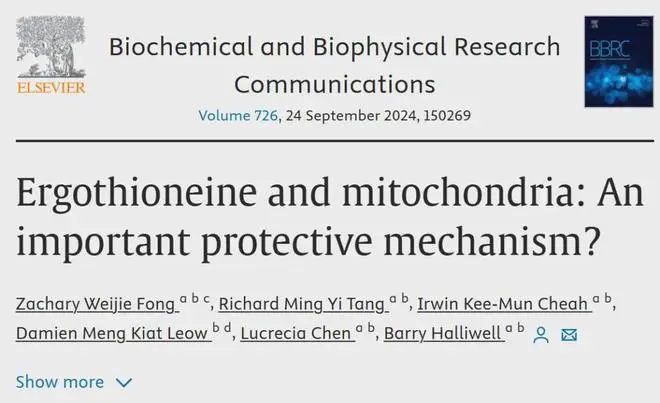
Reference:
Evans V, WU X M, TRAN K, et al. Impact of aging and ergothioneine pre-treatment on naphthalene toxicity in lung[J]. Toxicology Letters, 2024, 397: 89-102. DOI:10.1016/j.toxlet.2024.05.014.
Is age-related neurodegenerative disease caused by a lack of dietary compound ergotamine?
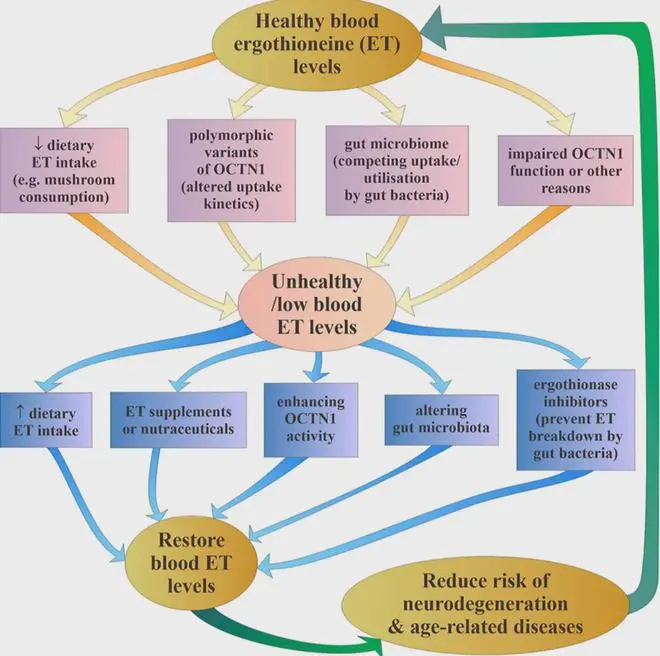
Abstract: Research suggests that dietary derived compound ergothioether (ET) is an important nutrient in the human body, especially for maintaining normal brain function. Low levels of ET in the body can significantly increase the risk of neurodegenerative diseases (cognitive impairment, dementia, Parkinson's disease) and other age-related diseases (including weakness, cardiovascular disease, and eye disease). Therefore, restoring ET levels in the body can help alleviate these risks, which are rapidly increasing due to global population aging. Preventing neurodegenerative diseases is particularly important because when dementia is typically diagnosed, the damage to the brain is extensive and may be irreversible. ET and vitamin E in the diet may act in parallel or even synergistically to protect different parts of the brain; Both may be 'neuroprotective vitamins'. This article reviews the solid scientific foundation that supports these recommendations regarding the role of ET.
Conclusion: Understanding the various mechanisms that lead to low ET levels will help identify strategies to improve these levels. The methods may include dietary changes, ET supplements, nutritional foods containing ET, OCTN1 activity enhancers, agents that alter the microbiome, and/or ergothionine enzyme inhibitors. Improving ET levels should reduce the incidence of neurodegenerative diseases, and perhaps other age-related diseases that are becoming a huge problem due to global aging. For a long time, the treatment of dementia has been limited, but recently there has been a surge in interest in clearing antibodies against amyloid beta protein (A β) deposits in the brain, hoping that this will prevent further damage caused by such deposits. The data shows that ET slows down the progression of cognitive impairment to a degree similar to A β clearance therapy, and is safe for human consumption and effective when taken orally. Its mechanism of action includes promoting neurogenesis, enhancing neuronal function, and promoting neuronal development. ET also has antioxidant and anti-inflammatory effects, creating a better environment for the proliferation of new neurons in the brain while preventing damage to existing neurons. Since ET can also prevent stroke, it can be inferred that it can also prevent brain swelling and bleeding caused by A - β clearance therapy. To evaluate this hypothesis, research should be conducted to test the possibility of synergistic effects between ET and Lecana Mab (as well as similar A - β clearance antibodies that may enter clinical use).
Reference:
HALLIWELL B, CHEAH L. Are age-related neurodegenerative diseases caused by a lack of the diet-derived compound ergothioneine? [J]. Free Radical Biology and Medicine, 2024, 217: 60-67.
YOU MAY LIKE
_1728976869676.webp)




